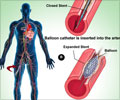- Heart attacks are becoming common in the younger population worldwide.
- High levels of Low Density Lipoprotein (LDL) or bad cholesterol considered a major risk factor for heart attacks.
- Healthy or increased High Density Lipoprotein (HDL) or good cholesterol levels shown to decrease heart attack risk.
- Recent study indicates that heart attacks in younger patients strongly associated with low HDL cholesterol levels rather than high LDL cholesterol levels.
Heart attacks in younger persons is more likely to be associated with low HDL cholesterol levels as opposed to high LDL cholesterol, according to a study slated for presentation at the American College of Cardiology’s 66th Annual Scientific Session.
Reason for the Study
It has been known that high LDL cholesterol and low HDL cholesterol levels increase heart attack risk in older individuals.- The authors wished to determine whether low HDL cholesterol levels irrespective of LDL cholesterol levels could have a significant impact on heart attack risk, especially in younger individuals (men less than 45 years and women less than 50 years).
- HDL cholesterol is a ‘modifiable factor’ for heartdisease, which means persons can take steps early to increase their HDL cholesterol levels such as the following to reduce their heart attack risk
- Maintaining a healthy weight
- Increased physical activity and exercise
- Quitting smoking
- Consuming a diet rich in fruits and vegetables and avoiding unhealthy trans fats
- Though studies have shown that hospital admission rates for heart attacks have decreased markedly by more than 20 percent over a 10-year period among patients with mean age of 75, there was no such reduction among patients under 55.
Details and Findings of the Study
The research team collected data from billing and medical records in two large medical centers. They identified a total of 813 patients; men less than 45-years-old and women less than 50-years-old who had been treated for a heart attack over the past 16 years. The average age of the patients was 48 years and 38 percent were women.The results of the study indicated that low HDL cholesterol level was the major abnormality in this group of patients.
"In this study of younger heart attack patients, low HDL-C was the most common abnormality, seen in approximately 90 percent of the men and 75 percent of the women," said Bradley Collins, a fourth-year student at Harvard Medical School and lead author of the study. "This finding suggests that low HDL-C should be considered a marker of increased heart attack risk in younger patients particularly."
LDL Vs HDL Cholesterol
Increased levels of LDL cholesterol, or "bad" cholesterol, is considered a risk factor for a heart attack or stroke, since it indicates that arteries are narrowed by build-up known as plaque.On the other hand, HDL cholesterol, known as "good" cholesterol, behaves like a scavenger, mopping up the blood to remove excess fat and bad cholesterol.
Message from the Study
- The findings of the study indicate that different tools might be needed to correctly determine heart attack risk in the younger age group. Traditional methods to determine heart attack risk might be under estimating the risk in younger persons by laying too much stress age.
- Low HDL cholesterol levels should be viewed as an independent marker for heart attack risk regardless of LDL cholesterol levels with prompt initiation of preventive measures such as dietary and lifestyle changes, good control of high blood pressure, blood sugar and at the same time medications to lower LDL cholesterol as appropriate.
One possible limitation of the current study is that it was restricted to two centers.
Type 2 Heart Attack in Younger Women
Also, in the current study, it was found that younger women suffering from heart attack were more likely to have a Type 2 heart attack, i.e. a problem other than a blocked artery causes decreased oxygen to heart."A Type 2 heart attack may occur in patients who have other very complicated medical conditions, including terminal cancer, internal bleeding or a severe bacterial infection," Collins said. "These heart attacks are often overlooked, given the severity of the patient’s main diagnosis."
Future Research Plans
The authors of the current study plan to follow-up on their findings in future studies.- Determine whether low HDL-C is associated with repeat heart attack risk in younger patients
- Identify whether there are specific genetic risk factors in this population
- Study prescribing patterns of statins in younger patients who are at increased risk for heart disease
- Develop new tools to determine heart attack risk in younger people.
- To conduct more studies on type 2 heart attack and determine how many patients die of heart disease as opposed to other causes.
References:
- Younger heart attack patients more likely to have low ’good’ vs. high ’bad’ cholesterol - (https://www.eurekalert.org/pub_releases/2017-03/acoc-yha030617.php)
Source-Medindia















